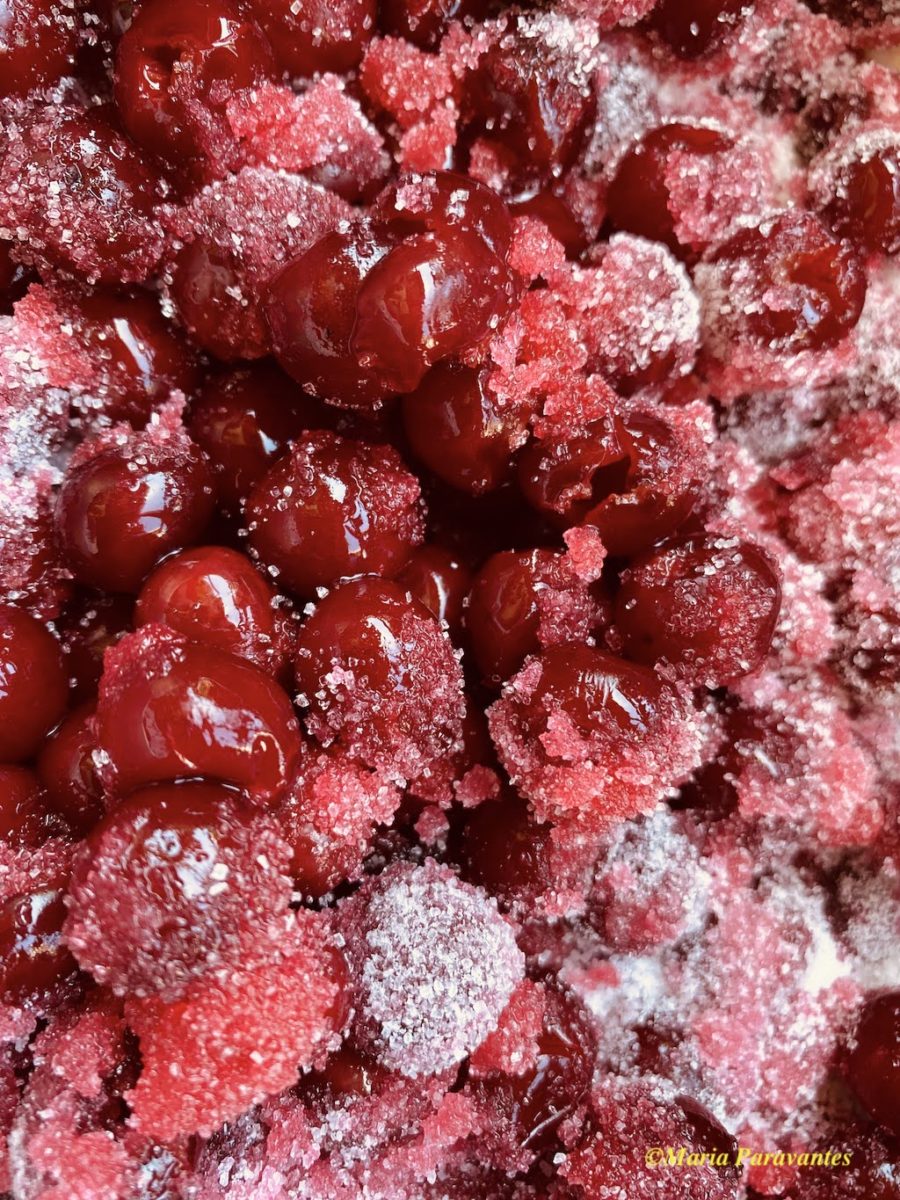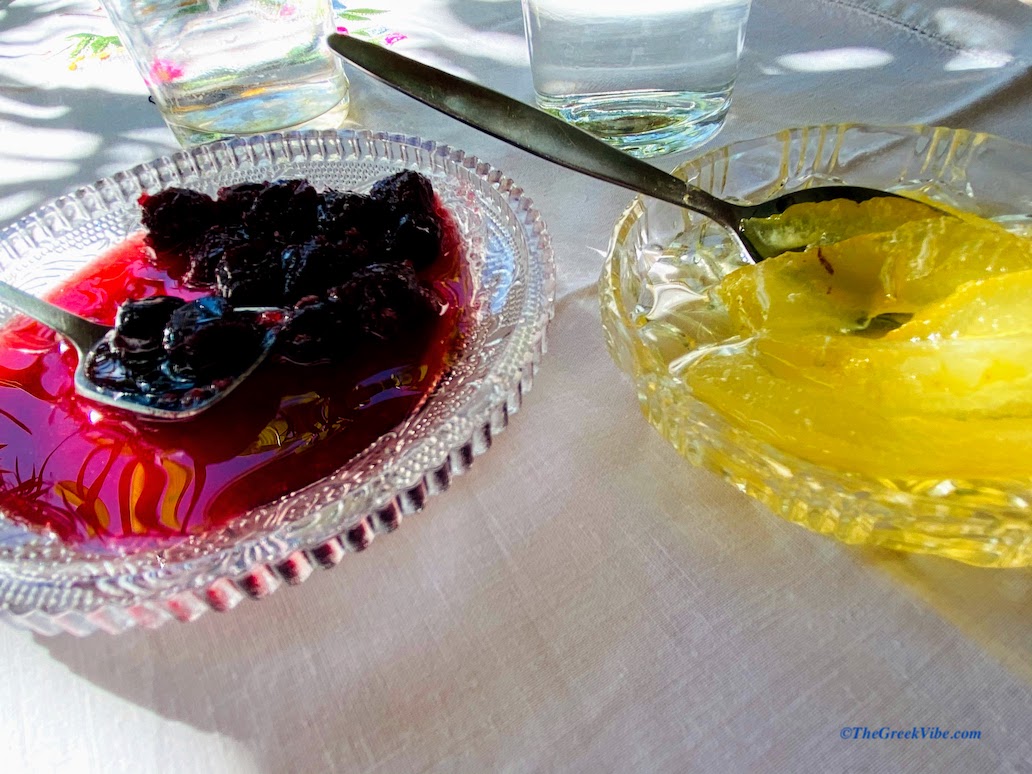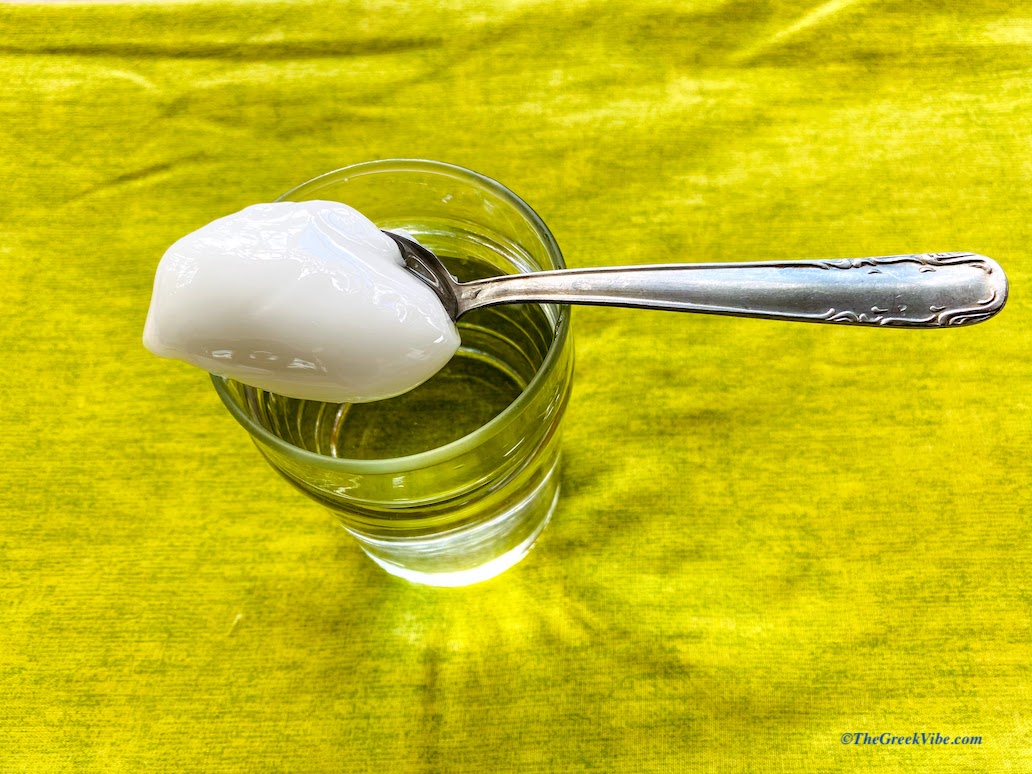“Glyka tou Koutaliou” or a sweet spoonful of Greek hospitality would best describe the most ubiquitous dessert in Greece and Cyprus. Served on ornate crystal plates with a spoon, of course, and some cold water, spoon sweets are not only an integral part of Greek cuisine, they are also a traditional gesture of hospitality and highly sought-after specialty food items.
On every Greek island, in every village, and even in the modern-day city, the “glyko tou koutaliou” (or sweet of the spoon) is offered to guests as a gesture of welcome.
What is a Spoon Sweet?
So what is a spoon sweet? The glyko tou koutaliou has evolved from the ancient practice of drying seasonal fruits and vegetables and combining with honey or molasses to preserve throughout the year.
In its current form (with sugar) it is believed to have come to Greece via traders from the East.
The spoon sweet can be made with virtually any fruit or vegetable though there are favorites depending on climate, location and local and seasonal production. So during your trip to Greece you will come across everything from nut sweets such as the “karydaki”, pistachio or “kastano glyko” to lemon blossoms and rose petal sweets. The variety is limitless, really: sour cherries, grapes, figs, and oranges. eggplant, watermelon, bitter oranges (neratzaki), carrot, sweet beet, tomato, mushrooms and olives. And on Cyprus, you may even come across onions, garlic and cucumber – for the sweet tooth!
Greek Hospitality on a Spoon
“Ti na se trataro?”, which means “what can I treat you”, is the second thing you’ll hear when you visit a Greek home. The first is, of course, “Kalosorises” (Welcome).
Once you take a seat, the host or hostess brings you atray with a tiny crystal plate and a spoonful of glyko tou koutaliou, a glass of water and some Greek coffee.
In the past, housewives took great pride in their spoon sweets. And when a gal made a perfect sweet, it definitely was a plus to attract her husband-to-be. It meant she had patience, good taste and was practical.
Traditionally, the sweet was served in a deep bowl on a silver tray accompanied by the home’s best silver dessert spoons and glasses of water. Guests would serve themselves. After a sip of some water they would say “Geia sta Heria Sou” (Blessings to Your Hands) as a sign that the sweet was a success.
Serving glyko tou koutaliou in Greece is very much like the tea ceremony in Japan and China. Tradition calls for a silver tray dressed in a preferably white crochet-knit tablecloth on which crystal plates ‘showcase’ the color of the sweet. Glasses of cold water must accompany and even coffee. You can still find these plates and spoons at vintage shops at the Monastiraki flea market or at village fairs.
Spoon sweets are also served at monasteries, kafeneia (coffee houses)and as of late at cafes.
Perfection in the Color & the Crunch

Though spoon sweets sound easy to make, they are not. There are secrets handed down from one generation to the next which can make or break the result.
I remember my grandmother would know if a sweet was a success just by looking at it. First she’d check out the color and then the consistency of the syrup. By then she knew what to expect. She made sure to tell me that a winning spoon sweet should have a bright color, a thick syrup, should not be overly sweet, and the fruit should retain its shape and slight crunch.
I should add that preparation also depends on the fruit. Some are made when ripe while others when still green. Some can go straight into the pot while others require a tedious procedure to remove the bitterness. And of course, the quality of the fruit is of foremost importance. For instance, the popular sour cherry (vissino) sweet features a variety of cherry found in two parts of Greece for only a month. The “milaraki” (small apple) is found in the fall in mountain regions, the lemon blossom is hand-picked in the spring.
What Spoon Sweet to Taste & Where
- Pistachio – Aegina
- Lemon blossom – Andros
- Karydaki – villages of Mount Parnonas
- Vissino – Arcadia
- Milaraki – villages of Mount Pelion
- Tomataki glyko – Santorini, Nysiros, Kos
- Koufeto (made of pumpkin and almonds) – Milos
- Triantafyllo glyko (rose petals) – Peloponnese
- Elia (olive) – Lesvos, villages of Roumeli and Messinia
- Sykalaki (fig) – Evia, mainland Greece
- Kastano (chestnut) – Kastanitsa, Karpenisi
- Frapa (grapefruit) – mainland Greece, Roumeli
- Kidoni (quince) – Naxos, Kefalonia (komfeto)
- Kumquat (a local citrus fruit) – Corfu
- Aspro (almond-based) – Skopelos
- Mouro – (berries, mulberry) – villages of Mt Pelion
I should add that this is just a basic guide of Greek spoon sweets and regions. There are sweets, such as the glyko triantafyllo (rose petals), which are made across Greece thanks to the fact that almost all homes had shrub roses along with the favorite basil plant.
Why Choose a Spoon Sweet

Traditional Greek spoon sweets are ideal for those of us who love sweets. The have no additives, are fat- and gluten-free, which means no cholesterol. And they can be low calorie because you’re only meant to eat a spoonful. And I promise, you’ll be satisfied with just that. Spoon sweets have virtually no expiry date. Thankfully, the glyko tou koutaliou is returning to the gastronomy scene because of all its rewards. As of late, dozens of cooperatives across Greece have popped up with local women preparing the finest homemade sweets with recipes handed down to them from their mothers and grandmothers. Young cafe and hotel owners are also serving spoon sweets as a healthier alternative supporting in this way local producers. What’s more, innovative Greek chefs are incorporating glyka toy koutaliou into their dishes and desserts.
Where Can I Add a Greek Spoon Sweet
Besides enjoying it in the traditional way I mention above, you can add glyko tou koutaliou to:
– Greek yogurt – for best taste add quince, grape, rose petal, strawberry or sour cherry
– as a cake topping or filling
– as a toppingfor ice cream, particularly vanilla or chocolate with best choices strawberry and sour cherry. I should add that one of the favorite desserts in Greece is kaimaki ice cream made of the mastiha resin from Chios and sahlep and served with sour cherry sweet and roasted almonds. You can also find a similar ice cream in Turkey called “dondurma”. Both ice creams should have a slightly chewy consistency.
– over rice pudding (rizogalo) or panna cota – best match grape or sour cherry sweet
– a topping for cheese cake – sour cherry all the way
– add a touch to pancakes or waffles – strawberry, grape, cherry, mulberry
– accompany cheese – fig and orange sweet
*note: when buying a spoon sweet avoid those that have glucose or added flavorings.
Meet the Ypovrichio Spoon Sweet

This spoon sweet is in a class of its own. Also known as “vanilia” or “mastiha” (depending on flavor), “ypovrichio” in Greek means “submarine” because this white chewy sweet comes on a spoon dipped in a long glass of crystal cold water. I remember when I was young we’d come from Chicago to Greece in the summers. At the kafeneion (coffee shop) in the central square my grandfather would order a vanilia for me. I couldn’t wait (or get enough).
Word has it that the fragrant indulgence – known in the past as “zaharokandio zymoto” – came to Greece via Arab traders. It is believed that the troops of Alexander the Great enjoyed “kand” – a Persian treat with honey and spices. It is perhaps this old Arabic word that came to be known as “candy”.
From there it traveled to the Greek communities of “Poli” – or Constantinople (modern-day Istanbul). When the Greeks were forced out of their homes in Turkey, and as refugees went to the Greek island of Chios, they added mastic oil. And so we have mastiha ypovrichio.

That’s the story behind this simple sweet “kerasma” (treat) that mainly in the ’50s-’60s-’70s could be found in every Greek household cupboard because it didn’t need to be stored in the fridge.
So loved was this confection, that the Greeks included it in their New Year’s carols (with its old name).
Today, the Ecumenical Patriarchate – the seat of the Orthodox church located in Constantinople, serves mastiha to its guests.
The true aromatic mastiha ypovrichio is made from the resin of the mastic tree known as mastiha. With dozens of health benefits, mastiha is a PDO product, which means that it is legally protected as unique to Chios product.
Meanwhile, kids still love the ypovrichio because it’s a delectable cross between a chewy candy and a lollipop. Today, you can find it in a variety of flavors besides vanilla and mastiha.
source: https://www.thegreekvibe.com/spoon-sweets-a-traditional-greek-dessert/












